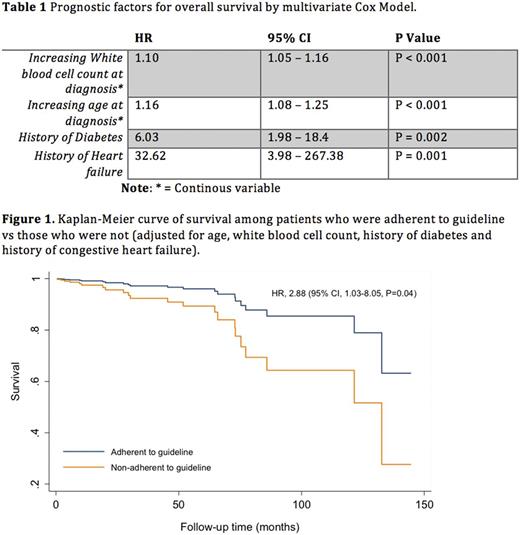Background
The aim of therapy for polycythemia vera (PV), a myeloproliferative neoplasm, is to reduce cardiovascular risk without increasing the risk of bleeding or hematological transformation. Current consensus guidelines suggest low dose aspirin and phlebotomy for patients at low-risk for thrombosis (<60 with no previous history of thrombosis); and hydroxyurea, low dose aspirin and phlebotomy for patients at high-risk for thrombosis (≥60 and/or history of thrombosis) (Tefferi & Barbui, Am J Hematol. 2015 Feb;90(2):162-73). Despite the existence of treatment guidelines, the real world practice of treating PV is not well studied.
Methods
We performed a retrospective cohort study of newly diagnosed JAK2V617F positive PV patients over the age of 18 between January 1, 2005 and January 1, 2017 in Hamilton, Ontario, Canada. The primary outcome was all-cause mortality. Secondary outcomes were non-fatal cardiovascular events, major bleeding, and hematological progression. Statistical analysis was performed in STATA using Cox proportional hazard models, and Poisson regression.
Results
A total of 112 patients (58.0% female) met inclusion criteria. The mean (SD) age at diagnosis was 70 (14) years. Median follow-up was 3.38 years (Range = 0.04-11.89). At diagnosis, 82.1% of patients were classified as high risk for thrombosis. At diagnosis cardiovascular risk factors were present in 69.6% of patients including previous thrombotic events in 27.5%. Symptoms of PV (e.g. pruritus, vasomotor, fatigue) were found in 52.7% of patients at diagnosis. Patients received treatment with phlebotomy (90.2%), aspirin (87.5%), and hydroxyurea (74.1%). Monotherapy was used in 6 (24%) of the non-guideline patients and was not found in the guideline group. Anticoagulants were used in 17.2% of patients. Overall, only 77.7% of patients received treatment that was consistent with guidelines regarding aspirin and hydroxyurea use.
A total of 22 (19.6%) of patients died during follow-up; increasing white blood cell count at diagnosis, increasing age at diagnosis, history of diabetes and history of congestive heart failure were associated with higher risk of death (Table 1). Patients who were not treated according to the guideline recommendations at any point during follow-up had an increased risk of death (HR, 2.88; 95% CI, 1.03-8.05; P<0.05, Figure 1). Non-fatal CV events occurred in 18 (16.1%) of patients, major bleeding in 10 (8.9%) patients, and hematological progression to AML, MF or MDS occurred in 7 (6.3%) patients. Mean (SD) emergency department (ED) visits per patient was 1.08 (2.80). The incidence of ED visits was significantly higher among those not receiving compared to those receiving guideline-directed treatment (Incidence Rate Ratio = 4.85; 95%CI, 3.38-6.96; P<0.0001).
Conclusion
This contemporary North American PV patient cohort study showed that the majority of newly diagnosed PV patients were older adults at high risk of thrombosis consistent with previous studies. The presence of cardiovascular comorbidities at diagnosis appeared to increase the risk of death. About three-quarters of patients in our cohort received treatment according to consensus guideline recommendations. Although the reasons for discordance with guidelines are uncertain, those who did not receive recommended therapy appeared to have an increased risk of death. The results of this study should be interpreted with caution due to the possibility of confounding by other factors that influence mortality. Future research regarding the barriers and facilitators of PV treatment guideline use, and the optimal strategy for assessment and management of cardiovascular risk factors may provide opportunities to improve care and patient outcomes.
Siegal: Novartis: Other: Focus Group; Bayer: Other: Focus group; BMS-pfizer: Other: Presentation; Servier: Other: Focus Group; Portola Pharmaceuticals: Other: Presentation. Hillis: Celgene: Other: Personal fees; Novartis Oncology: Research Funding; Bristol-Myers Squibb: Other: Personal Fees.
Author notes
Asterisk with author names denotes non-ASH members.


This feature is available to Subscribers Only
Sign In or Create an Account Close Modal